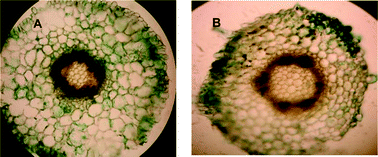Calcium phosphatenanoparticle mediated genetic transformation in plants†
Abstract
We have produced ultra-small sized (20–50 nm diameter)

* Corresponding authors
a Faculty of Engineering and Interdisciplinary Sciences, Jamia Hamdard (Hamdard University), Hamdard Nagar, New Delhi, India
b Department of Chemistry, University of Delhi, Delhi, India
c Department of Biotechnology, Jamia Hamdard (Hamdard University), Hamdard Nagar, New Delhi, India
d Department of Biomedical Sciences, Rajguru College of Applied Sciences, University of Delhi, Delhi, India
e
Department of Chemistry, Jamia Hamdard (Hamdard University), Hamdard Nagar, New Delhi, India
E-mail:
samim_chem@yahoo.co.in
Fax: +91-11-26059663
Tel: +91-11-26059688 (309) ext. 5557
We have produced ultra-small sized (20–50 nm diameter)

 Please wait while we load your content...
Something went wrong. Try again?
Please wait while we load your content...
Something went wrong. Try again?
S. Naqvi, A. N. Maitra, M. Z. Abdin, Md. Akmal, I. Arora and Md. Samim, J. Mater. Chem., 2012, 22, 3500 DOI: 10.1039/C2JM11739H
To request permission to reproduce material from this article, please go to the Copyright Clearance Center request page.
If you are an author contributing to an RSC publication, you do not need to request permission provided correct acknowledgement is given.
If you are the author of this article, you do not need to request permission to reproduce figures and diagrams provided correct acknowledgement is given. If you want to reproduce the whole article in a third-party publication (excluding your thesis/dissertation for which permission is not required) please go to the Copyright Clearance Center request page.
Read more about how to correctly acknowledge RSC content.
 Fetching data from CrossRef.
Fetching data from CrossRef.
This may take some time to load.
Loading related content
